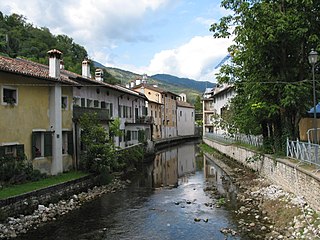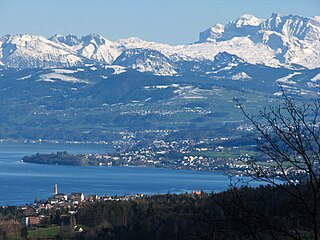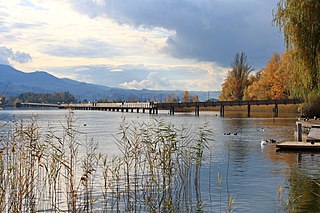
Feldbach is a village near Rapperswil, Switzerland. It is located on the north bank of the lake of Zurich and is part of the political municipality of Hombrechtikon. In the local dialect it is called Fäldbach.

Desenzano del Garda is a town and comune in the province of Brescia, in Lombardy, Italy, on the southwestern shore of Lake Garda. It borders the communes of Castiglione delle Stiviere, Lonato, Padenghe sul Garda and Sirmione.

Attersee am Attersee is a village on the western shore of Attersee lake in the Austrian state of Upper Austria.

Polpenazze del Garda is a comune in the province of Brescia, in Lombardy, northern Italy. It is situated near the western shore of Lake Garda.

Peschiera del Garda is a town and comune in the province of Verona, in Veneto, Italy. When Lombardy-Venetia was under Austrian rule, Peschiera was the northwest anchor of the four fortified towns constituting the Quadrilatero. The fortress is on an island in the river Mincio at its outlet from Lake Garda.

Feldafing is a municipality in Starnberg district, Bavaria, Germany, and is located on the west shore of Lake Starnberg, southwest of Munich.
Bodio Lomnago is a town and comune (municipality) located in the province of Varese, in the Lombardy region of northern Italy.

Polcenigo is a comune (municipality) in the Regional decentralization entity of Pordenone in the Italian region Friuli-Venezia Giulia, located about 110 kilometres northwest of Trieste, 95 kilometres (59 mi) north of Venice and about 14 kilometres (9 mi) northwest of Pordenone.

Sevrier is a commune in the Haute-Savoie department in the Auvergne-Rhône-Alpes region in south-eastern France.

Enge is a quarter in District 2 of Zürich, Switzerland.

The Au Peninsula is located on the Swiss Zürichsee lake shore in the municipality of Au, Canton of Zürich.

Holzbrücke Rapperswil-Hurden is a wooden pedestrian bridge between the city of Rapperswil and the village of Hurden crossing the upper Lake Zürich (Obersee) in Switzerland. The prehistoric timber piles discovered to the west of the Seedamm date back to 1523 BC. The island settlement Technikum is a prehistoric pile-dwelling settlement which is part of the UNESCO World Heritage Site Prehistoric Pile dwellings around the Alps. The first wooden footbridge led across Lake Zürich, followed by several reconstructions at least until the late 2nd century AD when the Roman Empire built a 6 metres (20 ft) wide wooden bridge. Between 1358 and 1360, Rudolf IV, Duke of Austria, built a 'new' wooden bridge across the lake that was used until 1878. On 6 April 2001, the reconstructed wooden footbridge was opened, being the longest wooden bridge in Switzerland.

Hurden is a village in the municipality of Freienbach in the canton of Schwyz in Switzerland. First mentioned in 1217, the name "de Hurden" was used for the peninsula and for the fish traps made of woven work, called "Hürden" or "Hurden", which were used by the locals.

Prehistoric pile dwellings around the Alps are a series of prehistoric pile dwelling settlements in and around the Alps built from about 5000 to 500 BC on the edges of lakes, rivers or wetlands. In 2011, 111 sites located variously in Switzerland (56), Italy (19), Germany (18), France (11), Austria (5) and Slovenia (2) were added to the UNESCO World Heritage Site list. In Slovenia, these were the first World Heritage Sites to be listed for their cultural value.

Robenhausen is a locality in Wetzikon, one of the municipalities of the canton of Zürich, Switzerland. The wetland Robenhauser Ried belongs to the protected area surrounding Pfäffikersee. The prehistoric pile dwelling around Lake Zurich Wetzikon-Robenhausen is part of the UNESCO-defined World Heritage Sites, the prehistoric pile dwellings around the Alps.

Kleiner Hafner is one of the 111 serial sites of the UNESCO World Heritage Site Prehistoric pile dwellings around the Alps, of which are 56 located in Switzerland.

Grossner Hafner is one of the 111 serial sites of the UNESCO World Heritage Site Prehistoric pile dwellings around the Alps, of which are 56 located in Switzerland.

Prehistoric pile dwellings around Lake Zurich comprises 11 – or 10% of all European pile dwelling sites – of a total of 56 prehistoric pile dwellings around the Alps in Switzerland, that are located around Lake Zurich in the cantons of Schwyz, St. Gallen and Zürich.

Rapperswil-Jona–Technikum is one of the 111 serial sites of the UNESCO World Heritage Site Prehistoric pile dwellings around the Alps, of which are 56 located in Switzerland. Located on a small former island on upper Lake Zürich in Rapperswil, a locality of the municipality of Rapperswil-Jona in the Canton of St. Gallen. Due to its location on a former island at the medieval Heilig Hüsli bridge chapel, the site sometimes is also referred to Rapperswil Heilighüsli or Inseldorf, meaning island village.
Wauwilermoos or Egolzwil 3 is one of the 111 serial sites of the UNESCO World Heritage Site Prehistoric pile dwellings around the Alps, of which are 56 located in Switzerland.



















